Apple iPad 2 GPU Performance Explored: PowerVR SGX543MP2 Benchmarked
by Anand Lal Shimpi on March 12, 2011 3:04 PM EST- Posted in
- Smartphones
- Apple
- iPad
- GLBenchmark
- iPad 2
- Mobile
- Tablets
GLBenchmark 2.0
GLBenchmark 2.0—as its name implies—tests OpenGL ES 2.0 performance on compatible devices. The suite includes two long benchmarking scenarios with a demanding combination of OpenGL ES 2.0 effects - texture based and direct lighting, bump, environment, and radiance mapping, soft shadows, vertex shader based skinning, level of detail support, multi-pass deferred rendering, noise textures, and ETC1 texture compression.
GLBenchmark 2.0 is the best example of an even remotely current 3D game running on this class of hardware—and even then this is a stretch. If you want an idea of how the PowerVR SGX 543MP2 stacks up to the competition however, GLBenchmark 2.0 is probably going to be our best bet (at least until we get Epic to finally release an Unreal Engine benchmark).
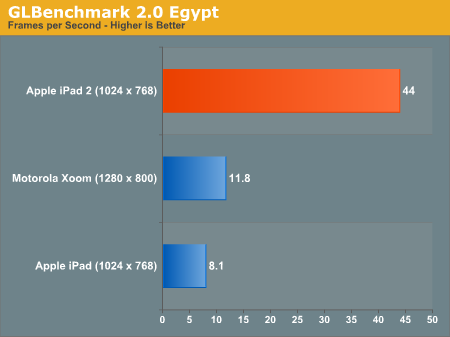
Without AA, the Egypt test runs at 5.4x the frame rate of the original iPad. It's even 3.7x the speed of the Tegra 2 in the Xoom running at 1280 x 800 (granted that's an iOS vs. Android comparison as well).
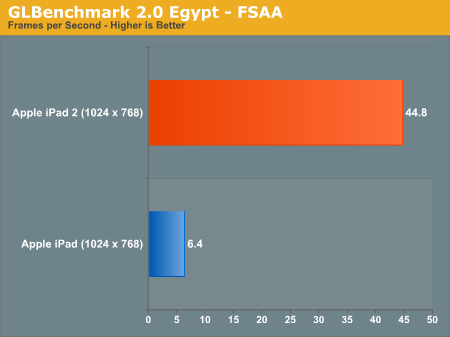
With AA enabled the iPad 2 advantage grows to 7x. In a game with the complexity of the Egypt test the original iPad wouldn't be remotely playable while the iPad 2 could run it smoothly.
The Pro test is a little more reasonable, showing a 3 - 4x increase in performance compared to the original iPad:
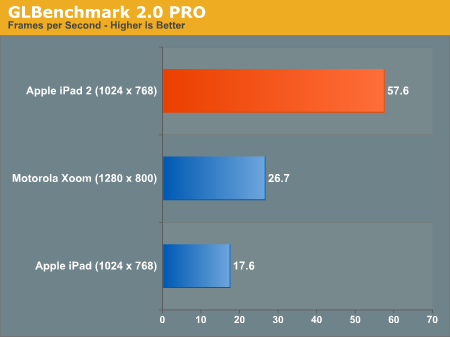
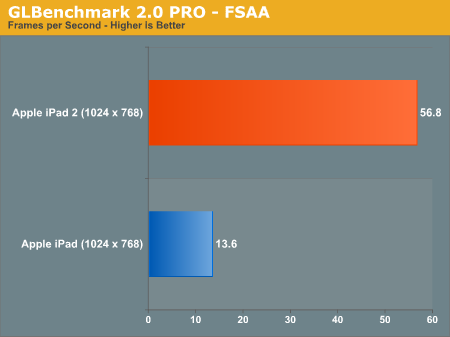
While we weren't able to reach the 9x figure claimed by Apple (I'm not sure that you'll ever see 9x running real game code), a range of 3 - 7x in GLBenchmark 2.0 is more reasonable. In practice I'd expect something less than 5x but that's nothing to complain about. We'll be doing power analysis over the weekend so expect more detail in our full review.
Putting the PowerVR SGX 543MP2 to Use: Infinity Blade
As we pointed out in our iPad 2 Preview, at least one developer already picked up on the amount of extra GPU horsepower in the new iPad 2. Epic put out an updated version of Infinity Blade with support for the iPad 2. Run it on an iPad and you'll get the same old Infinity Blade, but run it on an iPad 2 and you'll get more detail, higher resolution textures and anti-aliasing.
Remember that iPad and iPhone devices are more closed than your PC. There's no adjusting detail settings or resolution, so the target frame rate is usually what's fixed. Developers are simply able to deliver a better looking experience at roughly the same frame rate with upgraded hardware. In the case of Infinity Blade, load times are reduced thanks to the Cortex A9 CPU cores and there is some improvement in frame rate but the biggest impact comes from the improved visuals.
Below is the comparison beween Infinity Blade on the iPad and iPad 2 we ran in this morning's preview:

Mouse over to see Infinity Blade on the iPad 2
There's far more detail in the character models as well as the environment. Lighting looks improved and the AA is definitely appreciated.
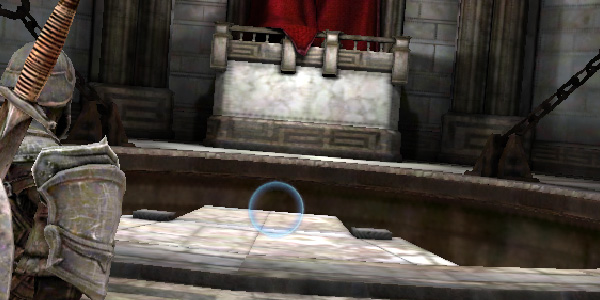
Mouse over to see Infinity Blade on the iPad 2
The gallery below has a bunch of side by side shots showing the improvements made to Infinity Blade for the iPad 2 vs. what you get when you run the game on a first generation iPad.
To Be Concluded...
We're still hard at work on our full iPad 2 review. We've got no less than four units running through battery life tests right now and there's still more to talk about in the review. We'll keep you posted, thanks for reading!


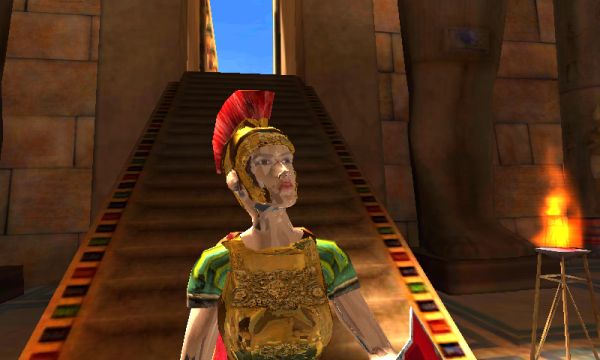














219 Comments
View All Comments
xype - Sunday, March 13, 2011 - link
Heh, that's starting to sound like a running gag. "Android: 6-12 months down the line, it will be Much Better™."Well, duh. Apple gets ahead every time they release a product, be it phone or tablet. None of the average consumers will ever care about Android if _right now_ it's not competitive and whatever Apple sells in their store is better than whatever Android vendors are selling.
Sure, yeah, 2-3 years down the road, Android devices will totally dominate the iPad 2. But something tells me that won't be what Apple will be selling at that point.
mrdeez - Sunday, March 13, 2011 - link
Like I said, Android will catch up and surpass apple. Apple is hindered by their closed system and marriage to itunes. I don't deny the ipad2 is a great device I just dont like any company forcing their policies on me.I use the current android phone domination as an example.
Android will dominate sooner than that but that is not my reason for wanting the xoom. I believe the ipad to be more of a casual CE and the xoom(and devices that use android) more professional.
Do I ant Apple to fail, NO!
I
jharper12 - Saturday, March 12, 2011 - link
Not really sure why Android folks get their panties in a bunch over stuff like this. I'm an Android user, and I'm thrilled every time Apple raises the bar. Tegra 3 is due out in August (allegedly) and is supposed to be five times as powerful as Tegra 2. Tegra 2 had the advantage for a time, now it got crushed. If we actually see Tegra 3 by the end of the year, hopeful here but not holding my breath, then Android tablets will have the performance advantage for 3-6 months. We're also not going to get a super high resolution display until Apple does it, so again, be thankful when Apple pushes other hardware companies to kick it up a notch. One thing's for sure, these benchmarks seem to indicate the iPad 3 will be able to push all those pixels around, pretty impressive stuff.ncb1010 - Saturday, March 12, 2011 - link
Define super high resolution display? Android was leading the iPhone by a wide margin in pixel density until 8 months ago. Same thing is happening with tablets. 30% more pixels on the xoom in practically the same surface area.jharper12 - Saturday, March 12, 2011 - link
Super high resolution = 2048 x 1536. Although I'd also accept 1920 x 1440 or 1920 x 1200. Yep, the Xoom has a higher resolution display, definitely a brilliant thing. I certainly wouldn't want to pay $500 for 1024 x 768, but 1280 x 800 is palatable. Personally I bought a Nook Color and a 32GB class 10 microsd card, for a total of $299. Sitting this gen out with a cheap alternative, power and resolution are going to see a serious bump in about a year.Yes, a myriad of manufacturers do eventually offer higher resolutions on the Android platform, but typically as screen makers come out with new products. Apple literally has a spec in mind, and finds a supplier that wants to reap the benefits of hundreds of millions in sales from a single company. See the difference?
It's widely rumored and entirely likely that the next iPad will have a resolution of 2048 x 1536. Any another manufacturer can match this, but it'll cost them more than it'll cost Apple. I've said in the past, and I'll say it again, Apple's real advantage is that they know they'll order 10 million of whatever they are making. When you can buy in that volume, you can get a 2048 x 1536 screen made that nobody else has widely available yet for an extremely competitive price. Think about it, that represents hundreds of millions of dollars for a screen manufacturer... it gives them the ability to start a new product line without any risk at all, the only downside being that all of their capacity will be taken up by one customer for a significant period of time.
Again, no need to get touchy or defensive. There's simply no denying that Apple can purchase in greater volumes with less risk than pretty much anyone else... although maybe Microsoft will be a resolution winner in the near future, Nokia is a serious hardware powerhouse.
ncb1010 - Sunday, March 13, 2011 - link
Apply the Apple Tax and it all evens out...lower component costs or not. A lot of these tablet manufacturers have their own display divisions and so the point about Apple being able to dictate what type of screens people make is really moot.solipsism - Sunday, March 13, 2011 - link
You’re referring to less than accurate sub-pixel counting on AMOLED displays. Not exactly a slam dunk.So it’s been almost a year since the 326ppi iPhone 4 display was demoed. Where are the competing displays? Why doesn’t the iPhone 4 have a bad rap for rendering graphics with 4x the pixels of the original iPhone when the 23% higher pixel number is being stated as being the reason why the iPad 2 kicks its ass so thoroughly and why the iPad 1 is right on its ass?
Juzcallmeneo - Sunday, March 13, 2011 - link
Retina is nice, Super AMOLED is gorgeous.. and Super AMOLED Plus is cleaner, brighter, and lower power usage (Supposedly). I wish a tablet would have that for a screen. Samsung makes Apple's A5..why can't they put that screen on it?ncb1010 - Saturday, March 12, 2011 - link
Do a benchmark that uses more than 512 mb of VRAM and watch iPad 2's score crash.rish95 - Saturday, March 12, 2011 - link
Uhh...more than 512MB VRAM on a display like that? Never ever gonna happen..unless you're playing Crysis 2. To use over 512MB in most titles you need to hit 1680 x 1050 or even 1920 x 1080.